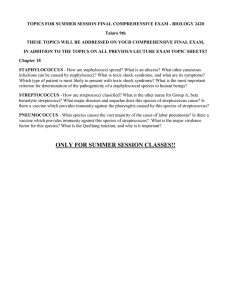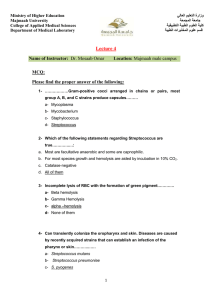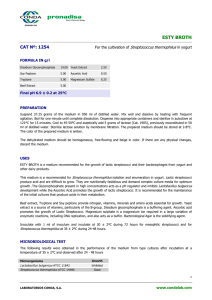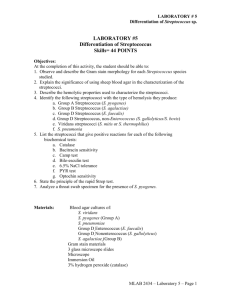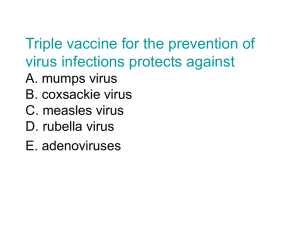LABORATORY #5 Differentiation of Streptococcus Skills= 44 POINTS
advertisement
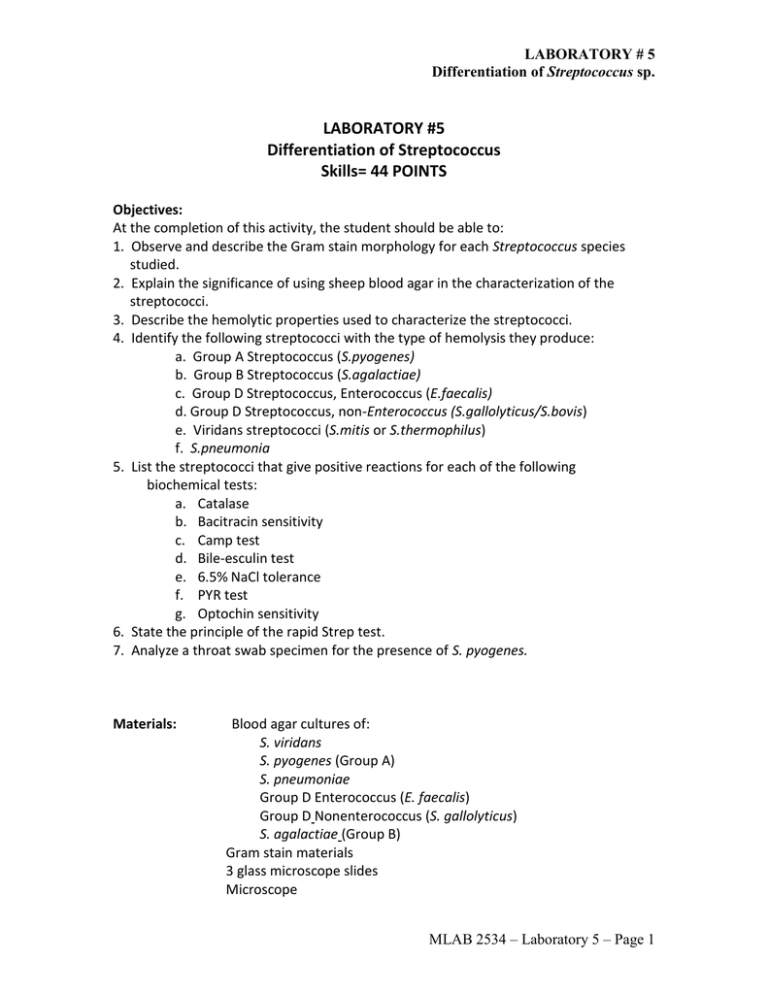
LABORATORY # 5 Differentiation of Streptococcus sp. LABORATORY #5 Differentiation of Streptococcus Skills= 44 POINTS Objectives: At the completion of this activity, the student should be able to: 1. Observe and describe the Gram stain morphology for each Streptococcus species studied. 2. Explain the significance of using sheep blood agar in the characterization of the streptococci. 3. Describe the hemolytic properties used to characterize the streptococci. 4. Identify the following streptococci with the type of hemolysis they produce: a. Group A Streptococcus (S.pyogenes) b. Group B Streptococcus (S.agalactiae) c. Group D Streptococcus, Enterococcus (E.faecalis) d. Group D Streptococcus, non-Enterococcus (S.gallolyticus/S.bovis) e. Viridans streptococci (S.mitis or S.thermophilus) f. S.pneumonia 5. List the streptococci that give positive reactions for each of the following biochemical tests: a. Catalase b. Bacitracin sensitivity c. Camp test d. Bile-esculin test e. 6.5% NaCl tolerance f. PYR test g. Optochin sensitivity 6. State the principle of the rapid Strep test. 7. Analyze a throat swab specimen for the presence of S. pyogenes. Materials: Blood agar cultures of: S. viridans S. pyogenes (Group A) S. pneumoniae Group D Enterococcus (E. faecalis) Group D Nonenterococcus (S. gallolyticus) S. agalactiae (Group B) Gram stain materials 3 glass microscope slides Microscope MLAB 2534 – Laboratory 5 – Page 1 LABORATORY # 5 Differentiation of Streptococcus sp. Immersion Oil 3% hydrogen peroxide (catalase) 1 Bacitracin disk (Taxo A) 2 blood agar plates (BAP) 2 PYR tests 3 tubes Bile Esculin Azide 2 tubes 6.5% NaCl 2 Optochin disk (Taxo P) Strep Typing Kit Rapid Strep Kit 1 Unknown Patient Throat Swab References: 1. Mahon and Manuselis, Textbook of Diagnostic Microbiology, Third Edition, Chapter 15 2. Clinical Microbiology Procedures Handbook, volumes 1 and 2, ASM Press, 1992. 3. BBL Dryslide PYR kit product insert 4. Key Scientific PYR Disc product insert 5. BBL Streptocard Acid Latex test product insert 6. PathoDx Strep Grouping product insert 7. BD BBL Taxo Discs for Differentiation of Group A Streptococci product insert Discussion: Organisms of the genus Streptococcus are capable of inducing infection in every organ and tissue of the body. Most pathogenic species of the streptococci are aerobic, but a few are anaerobic or microaerophilic. Streptococci can be divided into groups based on hemolytic activity, biochemical tests, and colony morphology. Procedure: 1. Colony Morphology, Hemolytic Properties, Gram Stain, and Catalase In addition to being grouped according to serological properties, Streptococci may also be classified according to the type of hemolysis produced on sheep blood agar. This type of grouping is referred to as Brown’s classification. The four types of hemolysis are alpha, beta, gamma, and alpha prime. Alpha hemolysis is caused by partial lysis of the red cells in blood agar, allowing hemoglobin to be released and its subsequent degradation to biliverdin. It is characterized by an indistinct zone around the colony with a greenish or brownish discoloration. MLAB 2534 – Laboratory 5 – Page 2 LABORATORY # 5 Differentiation of Streptococcus sp. Beta hemolysis is caused by complete lysis of the red cells characterized by a clear, colorless zone around the colony. Gamma hemolysis is actually a misnomer in that there is no apparent hemolysis or discoloration around the colony of blood agar. a. Working in pairs, describe the colony morphology and hemolytic properties of each Streptococcus isolate on the report form at the end of this exercise. b. Prepare smears of each Streptococcus isolate. You will make a total of six (6) smears, putting two (2) smears on each slide. c. Gram stain each strep isolate and enter the results on the report form. d. Perform a catalase test on each strep. Be careful not to take any blood agar with the colonies! This can result in a false positive. 2. Bacitracin Sensitivity Group A Streptococcus may be differentiated from other Streptococci by its sensitivity to low concentrations of bacitracin. A paper disk containing 0.04 U bacitracin (Taxo A) is used for this test. a. Heavily inoculate a section of the blood agar plate with the suspected Group A strep. b. Gently press a “A” disk to the inoculated surface of the BAP using forceps. c. Incubate the plate overnight in a CO2 incubator at 37 OC. d. Any zone of inhibition of growth around the disk after overnight incubation is positive identification of Group A Streptococcus (S.pyogenes). This means that the organism is susceptible to the bacitracin. Indicate the results for this organism as “positive” on the report form. e. Absence of a zone of inhibition means that the organism is not susceptible or killed by the bacitracin. Report this out as “negative.” 3. Camp Test- INSTRUCTOR DEMO ONLY Group B β-hemolytic streptococcus produces an extracellular enzyme, “CAMP” factor (an acronym of the authors who initially described this phenomenon). This CAMP factor intensifies the lysis of sheep red cells when placed in the appropriate inoculation points with S.aureus. The β-lysin produced by the staphylococci, in conjunction with the CAMP factor, produces an arrowhead-shaped hemolysis at the junction between the streptococci and staphylococci streaks. a. Inoculate a blood agar plate with S.aureus by making a single streak across the center of the plate. b. Streak the S.agalactiae (Group B) at right angle to the staphylococci streak, using the sideways part of the loop, to within 5 mm. MLAB 2534 – Laboratory 5 – Page 3 LABORATORY # 5 Differentiation of Streptococcus sp. c. Incubate the plate overnight in a 35oC, non-CO2 incubator. d. Group B strep will exhibit an “arrowhead” of hemolysis. This would indicate a positive result. 4. Group D Streptococcus Differentiation Group D streptococcus is a classification of streptococci that may produce alpha, beta, or gamma hemolysis on sheep blood agar. It may be isolated from blood in subacute bacterial endocarditis, from specimens in urinary tract infections, or from wounds and deep abscesses. The Group D streptococci are divided into two groups: (1) Enterococci and (2) Nonenterococci. It is important that this differentiation be made because enterococci are less susceptible to penicillin than are other streptococci. In some cases of severe infection, combined therapy with two or more antimicrobial agents must be used. Bile Esculin Test The bile-esculin test is based on the ability of certain bacteria, notably the Group D streptococci, to hydrolyze esculin in the presence of 1% to 4% bile. Bacteria capable of growing in bile and also hydrolyzing esculetin produce glucose and the aglycone esculetin in an appropriate medium. Esculetin reacts with an iron salt to form a dark brown or black complex. a. Streak three (3) bile esculin slants heavily with S.agalactiae, E.faecalis, and S.gallolyticus respectively. b. Incubate overnight and observe the slant for diffuse blackening of the slant, which is a positive reaction. c. Record results as either “positive” or “negative” on the report form. 6.5% NaCl Tolerance Once a streptococcus is identified as belonging to the Group D (positive bile esculin reaction) streptococci, it is necessary to determine whether it is an enterococcus or one of the non-enterococcus species. Enterococci will grow and produce acid in heartinfusion broth containing 6.5% sodium chloride; non-enterococci are inhibited from growing in this concentration of salt. Thus, with the bile-esculin and salt tolerance tests, three presumptive identifications are possible: Bile esculin + = + 6.5% NaCl + = = Presumptive ID Enterococcus Streptococcus Group Non-enterococcal Gp. D MLAB 2534 – Laboratory 5 – Page 4 LABORATORY # 5 Differentiation of Streptococcus sp. streptococcus a. Inoculate two tubes of 6.5% NaCl medium with E.faecalis and S.gallolyticus respectively. b. Incubate for 48 hours and observe for turbidity in the medium which indicates a positive test. c. Record results as either “positive” or “negative” on the report form. PYR Tests The PYR test is a qualitative procedure to determine the ability of streptococci to enzymatically hydrolyze L-pyrrolidonyl-β-naphthylamide by the enzyme pyrrolidonyl peptidase. PYR tests are often used in the clinical setting for a rapid, presumptive, result. PYR Disc a. Place 1 disc onto a slide and moisten slightly with diH20. b. Inoculate heavily with a loopful of Enterococcus from a fresh culture. c. Wait 2 minutes at room temperature, then add 1 drop of PEP reagent. Wait 2 minutes for color to develop. Interpretation: The appearance of a dark pink to red color is a positive reaction. No color change indicates a negative result. Results should be reported as either “positive” or “negative” on the report form. d. Repeat steps a- c using the Viridans streptococci. 5. Optochin Susceptibility Optochin (ethylhydroxycupreine hydrochloride), a quinine derivative, selectively inhibits the growth of S. pneumoniae in very low concentration. Optochin may inhibit other alpha-hemolytic streptococci, but only at higher concentrations. a. b. c. d. e. f. Split a BAP and label the plate with S.pneumonia on one side, and Streptococcus viridians on the other. On one half of the plate, inoculate S.pneumoniae heavily. On the other half of the plate, inoculate Strep viridans heavily. On one half on the BAP, place a disk impregnated with optochin (Taxo P) on the thickly inoculated area of S. pneumoniae. On the other side of the BAP, place a disk impregnated with optochin (Taxo P) on the thickly inoculated area of S. viridians. Incubate overnight in a 35OC, CO2 incubator. MLAB 2534 – Laboratory 5 – Page 5 LABORATORY # 5 Differentiation of Streptococcus sp. g. h. A zone of inhibition of growth ≥ 14 mm is considered a positive test for S. pneumoniae. No zone of inhibition is consistent with alpha streptococci other than S. pneumoniae. Report results as either “positive” or “negative”on the report form. 6. Streptococcus Typing Kits Β- hemolytic streps can be differentiated into Lancefield groups based on specific carbohydrate antigens. This procedure uses an acid latex to extract the antigens for a rapid ID. The latex test particle will agglutinate in the presence of a homologous antigen. BBL Streptocard Acid Latex Test Kit a. Label one 12 X 75 mm test tube for each specimen (Group A/ Group B Streptococci) to be tested. b. Add 3 drops of extraction reagent #1. c. Add 3 drops of extraction reagent #2, a color change from blue to orange/yellow will be seen. d. Select 3-5 similar β- hemolytic colonies with a loop and emulsify in the extraction solution. e. Add 3 drops of extraction reagent #3, color will revert to a pale blue. f. Dispense 1 drop from each test latex onto a separate circle. g. Add 1 drop of extract to each of the circles, in a separate area of the circle. h. With a mixing stick, spread over the entire area of the circle. Use a separate stick for each. i. Rock the card manually for 1 minute and observe for agglutination, macroscopically. Interpretation: A positive reaction is called when agglutination occurs within 1 minute with the test latex. Note: if more than one test latex strongly agglutinates, the possibility of a mixed culture exists. Results should be recorded as “positive” or “negative” on the report form. PathoDx Strep Grouping Kit a. Label one 12 X 75 mm test tube for each specimen (Group A/ Group B Streptococci) to be tested. b. Add 2drops of extraction reagent #1(cap color: red). c. Add 2 drops of extraction reagent #2(cap color: blue). d. Select 3-5 similar β- hemolytic colonies with a loop and emulsify in the extraction solution. e. Add 4 drops of extraction reagent #3(cap color: green). f. Dispense 50μL ( 1-2 drops) of extract to each of five test ovals. MLAB 2534 – Laboratory 5 – Page 6 LABORATORY # 5 Differentiation of Streptococcus sp. g. Add 1 drop of Strep A latex to the first oval, in a separate area of the circle, and 1 drop of Strep B latex to the second oval, in a separate area of the circle. Continue in the same manner, adding Strep C, F and G latex to the remaining 3 ovals. h. With a mixing stick, spread over the entire area of the circle. Use a separate stick for each. i. Rock the card manually for up to 1 minute and observe for agglutination, macroscopically. Interpretation: A positive reaction is called when agglutination occurs within 1 minute with the test latex. Note: if more than one test latex strongly agglutinates, the possibility of a mixed culture exists. Results should be recorded as “positive” or “negative” on the report form. 7. Rapid Strep Tests Throat swab specimens must be collected properly in order to obtain accurate results. Do not use calcium alginate swabs. For best results use a dacron or rayon swab for both the patient specimen and the Positive Control. Cotton swabs are not recommended as they tend to release fibers making the agglutination difficult to interpret; in addition, some are too tightly wound to deliver adequate volumes of extract onto the test plate. The swabbing technique used to collect the specimen is as important to the test result as is the performance of the test. The throat swab specimen must be collected under direct visualization with good lighting. The pharynx and tonsils must be adequately exposed and vigorously rubbed with a sterile rayon or Dacron ® tipped swab. The tongue, uvula, and cheeks must be avoided. Any exudate present should also be touched with the swab. The swab can be tested immediately or held up to 72 hours. If culture results are desired, the swab may be streaked onto a blood agar plate before performing the Rapid Test. a. b. c. d. Note the kit brand and expiration date on your report sheet. The Instructor will perform the external quality control. Log the QC results on your report form. You will be given one (1) unknown swab. Note the patient name and ID on your report sheet. Perform one of the direct antigen tests on the unknown specimen and record the results. Follow kit instructions. MLAB 2534 – Laboratory 5 – Page 7 LABORATORY # 5 Differentiation of Streptococcus sp. MLAB 2534 – Laboratory 5 – Page 8 LABORATORY # 5 Differentiation of Streptococcus sp. Presumptive Identification of Streptococci Test Group A Group B Enterococcus Hemolysis β β* α,β,γ Bacitracin + -* -* CAMP +* -* Hippurate +* -* Bile-* +* Esculin 6.5% NaCl -* +* Optochin -* -* & Bile Solubility Catalase -* -* PYR + -* +* * Occasional exceptions occur. Grp. D, not Enterococcus Pneumococci α,γ -* -* -* +* Viridans, Non-Grp. D α,γ +* -* -* -* -* -* -* -* + -* -* -* -* - α ± - Quality Control Quality control ensures that the information generated by the laboratory is accurate, reliable, and reproducible. This is accomplished by assessing the quality of the specimens, monitoring the performance of test procedures, reagents, media, and personnel. For the reagents used in this lab, QC should be performed weekly and on each new lot or shipment of the product using ATCC control organisms. Results should be reported in the QC log. Components of kit tests should not be interchanged with those from another kit. Technical Notes Most clinical laboratories do not use all of these methods to identify members of the genus Streptococcus. In the consideration of time, rapid tests, such as the strep typing or PYR are used instead of tube testing which requires a 24 hour incubation time. MLAB 2534 – Laboratory 5 – Page 9 LABORATORY # 5 Differentiation of Streptococcus sp. Lab #5: Streptococcus Differentiation Report Form Points= 37 Name ___________________________________ Date _______________________ Test Group A: S. pyogenes Group B: S. agalactiae Enterococcus Grp. D, NonEnterococcus Viridans, NonGrp. D Pneumococci Hemolysis Colony Morphology Gram Stain Catalase Bacitracin (Taxo A) CAMP Bile Esculin 6.5% NaCl PYR Optochin (Taxo P) Strep Typing MLAB 2534 – Laboratory 5 – Page 10 LABORATORY # 5 Differentiation of Streptococcus sp. Lab #5: Rapid Strep Testing Report Form Points= 7 Name ___________________________________ Date _______________________ Kit brand:_______________________________________ Expiration date:___________________________________ Results Positive Control Negative Control Patient name: Patient ID: Patient result: MLAB 2534 – Laboratory 5 – Page 11 LABORATORY # 5 Differentiation of Streptococcus sp. Name:_________________ Date:__________________ Points: 11 Lab #5: Differentiation of Streptococcus Study Questions What test differentiates Streptococci from Staphylococci?(1 pt) 1. 2. Describe what α, β, and gamma hemolysis look like on SBA( sheep blood agar). Why is this reaction important in the ID of streptococci? (4 pts.) 3. Based on the below descriptions, identify the organism. (3 pts.) Gram stain reaction GPC GPC GPC Media BAP: beta hemolytic BAP: gamma hemolytic BAP: gamma hemolytic Biochemicals Catalase: neg PYR: pos Catalase: neg PYR: neg Bile esculin: turned black 6.5% NaCl: no growth Catalase: neg PYR: pos Bile esculin: turned black 6.5% NaCl: growth Organism 4. The optochin disk test is incubated at/in _____________________.(1 pt.) 5. Taxo A is ________________________. (1 pt.) 6. Taxo P is _________________________. (1 pt.) MLAB 2534 – Laboratory 5 – Page 12
